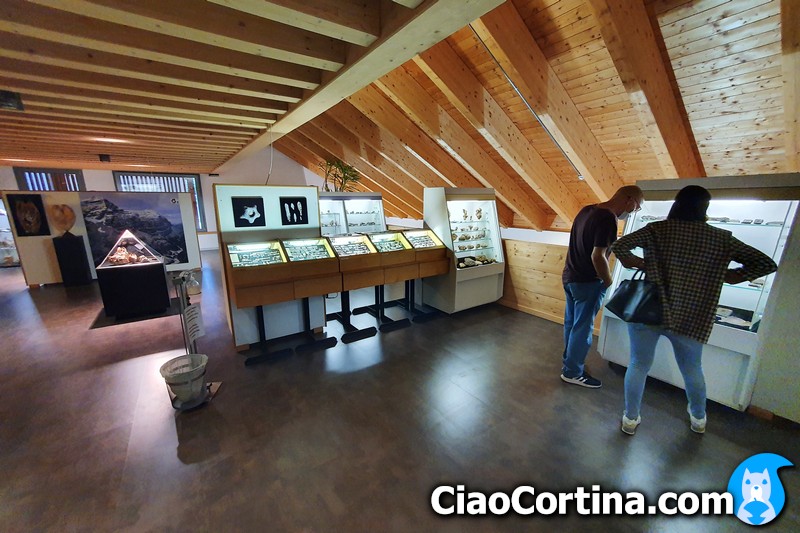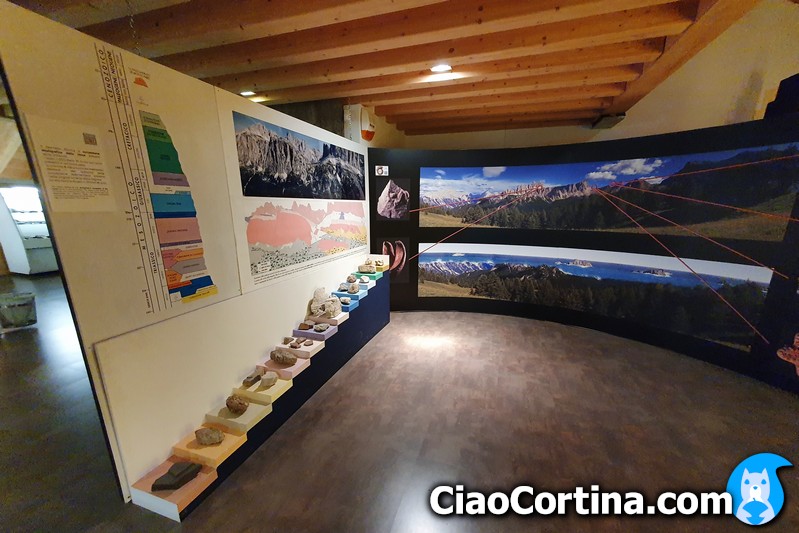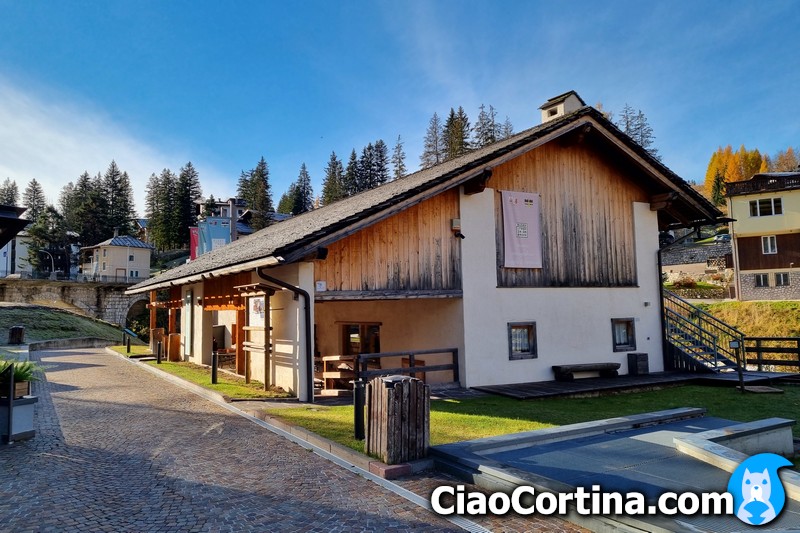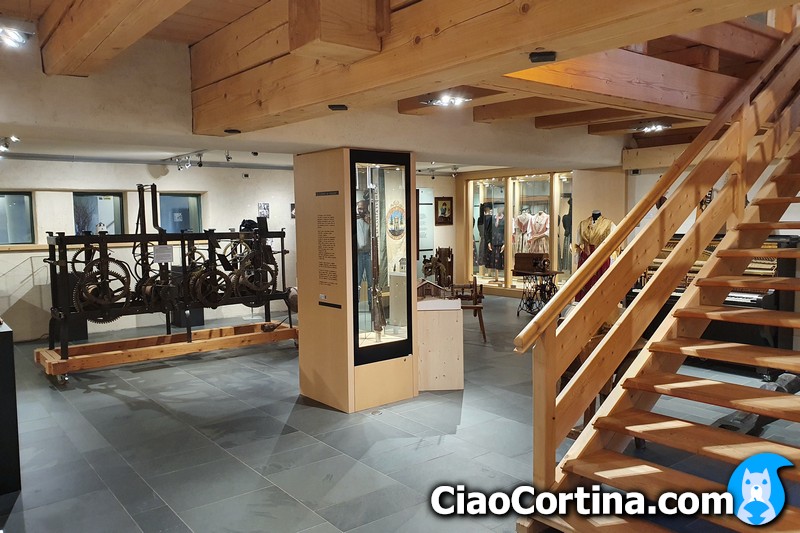Introduction
The museums of the Regole of Cortina d'Ampezzo are three museums that have been built to keep alive the culture and tradition in the Ampezzo valley. The Modern Art Museum "Mario Rimoldi" is an art gallery housed inside the "Ciasa de Ra Regoles." The Palaeontological Museum "Rinaldo Zardini" and the Ethnographic Museum "Regole d'Ampezzo" are housed inside the Alexander Hall, a multi-purpose center located a few steps from the center of Cortina.

Modern Art Museum "Mario Rimoldi"
The Modern Art Museum "Mario Rimoldi" in Cortina d'Ampezzo was inaugurated in 1974 after the donation by Mrs. "Rosa Braun," the widow of "Mario Rimoldi," who gave her family art collection to the "Regole d'Ampezzo."

The collection boasts over three hundred paintings and is considered one of the most complete private collections of modern Italian art. In the museum are shown the works of many great Italian painters of the early 1900s, including artists such as De Chirico, Morandi, Martini, De Pisis, and Rotella.

The exhibition, developed on two floors, allows you to see many great paintings, such as "the French Soldier" by De Pisis, "the Bathers" by Carena, "the Zolfara" by Guttuso, "San Sebastiano" by Garbari, "Ile des charmes" by Savinio, and "Concerto" by Campigli, among with many others.
It is surely worth a visit, whether you are an art lover or just curious, and also because the price of the ticket is really honest. For more information, we invite you to visit the official website of the Rimoldi Museum.

Rimoldi has been not only a great art lover but also a very important character for the cultural growth of Cortina d'Ampezzo, both as mayor and as president of several cultural associations. His life was very intense; after he studied hotel management in Rome, he became passionate about art and started collecting the works of emerging artists, such as De Pisis.

With the expansion of his collection, he met many representatives of the artistic environment of the time, which led him to organize several exhibitions in Cortina, first provincial and then national.
In addition to being a great art lover, Rimoldi was also the manager of the Hotel Corona of Cortina. Over the years, he hosted various artists, including, for example, Giorgio De Chirico, who spent his Christmas vacations there, even composing a poem for the occasion.

Rimoldi's life was undoubtedly very full. If you want to learn more about him, you could read the Wikipedia page dedicated to him, but consider that it's in Italian.
 Help us stay ad-free with a small offer.Donate now!
Help us stay ad-free with a small offer.Donate now!
Palaeontological Museum "Rinaldo Zardini"
The Paleontological Museum "Rinaldo Zardini" was founded in 1974 thanks to a donation by Rinaldo Zardini, who wanted to spread the geology and paleontology culture of the Ampezzo Dolomites to everyone.

It is one of the largest existing collections of fossils, with over twenty thousand specimens belonging to over one thousand different species. Inside the museum, it's possible to see many finds of marine creatures that lived in these areas before the continental drift made the Dolomites emerge from the water.
... It is one of the largest existing collections of fossils, over 20,000 specimens...
The fossils are perfectly preserved, and, in most cases, you can see even the smallest details, such as the holes with which the sponges absorbed water, despite the fact that almost two hundred and fifty million years have passed.

Scholars from all over the world come to visit this collection. Over the years, it has been further expanded with the help of many enthusiasts who have found new specimens, including plant fossils.
Among the most significant materials on display, there are numerous specimens of Megalodon bivalves, organisms adapted to a tropical marine environment, such as the one that preceded the genesis of the Dolomites. A small space is also dedicated to the reconstruction of Zardini's personal study.

The collection is one of the most complete in Europe and also includes some specimens of amber millions of years old. Few know that Cortina is a very interesting area from a paleontological point of view.
Under the mountain group of Mount "Tofane" have been discovered the most ancient invertebrates preserved in amber in the world. They are over two hundred and thirty million years old, almost one hundred million years older than any other invertebrates preserved in the amber ever found globally. The amber has been called "Ampezzoa Triassica," in honor of the Ampezzo valley.

This discovery was really important for geologists around the world; it could be said that it changed history. Here you can read a scientific article, in English, that deepens the topic.
The Palaeontological Museum "Rinaldo Zardini" is, undoubtedly, a beautiful museum, especially for those who have children, because they can actually see the story of the world and not read it in textbooks. We sincerely recommend the visit of this museum to everyone, as it is objectively interesting, not only for a didactic purpose. For more information, here is the official website of the Palaeontological Museum.

We want to conclude this chapter with a few words about Rinaldo Zardini: he was born in Cortina in 1902 and has always been a great lover of photography. His naturalistic activity began with the cataloging of Ampezzo's biodiversity, the results of which can be seen in the first room of the museum.
In 1935 Rinaldo collected his first fossil, and since then, he has continued to collect, study, and catalog various fossil finds, resulting in one of the largest and most interesting collections in the world. A large part of Zardini's studies focused on the fauna of the Ladin era, one of the triassic epochs.

He approached the subject of fossils so well that his books have become university study texts. The most important work of Zardini was undoubtedly "Fossils of Cortina: An Atlas of Echinoderms" of 1973.
... he was awarded with the degree honoris causa in natural sciences...
The contribution of Zardini to the world of fossils was so large that he was awarded the degree "honoris causa" in natural sciences and was appointed an affiliated researcher of the Smithsonian Institute of Washington.
If you would like to learn more about the geological history of Cortina, we also invite you to read our article. You can find it below:

 Help us stay ad-free with a small offer.Donate now!
Help us stay ad-free with a small offer.Donate now!
Ethnographic museum "Regole d'Ampezzo"
The Ethnographic Museum "Regole d'Ampezzo" is an exhibition dedicated to the culture of Ampezzo and its traditions. This cultural heritage has been preserved over the centuries, thanks to the supervision of the territory by the "Regole d'Ampezzo."
The museum is housed in an historic Venetian-style sawmill, whose building has been completely renovated.

The museum is structured on three floors, each dedicated to a specific theme but all concerning the history of Cortina and the "Regole d'Ampezzo."
It goes from life in the mountains, with in-depth studies of the various forestry and pastoral activities, to the ingenious solutions adopted to guarantee all the families a fair lifestyle.

For centuries, and in part still today, life in Ampezzo was regulated by the "Laudi," which is a set of rules that define the rights and duties of the families of Cortina. All of this was done, for example, to ensure that citizens received free wood for home repairs or for fire, ensuring equity of division and sustainability of wood collection.

In addition to testimonies of that lifestyle, you can also admire some of the local handicrafts, such as silver filigree and traditional clothes.
Among all the exhibits, there are two that most attracted our attention. The first is the "Gilardoni" rifle, the world's first compressed air lethal weapon. It was really silent and didn't create smoke, so it gave a huge tactical advantage. It was built by Bartolomeo Gilardoni, a watchmaker and blacksmith native to Cortina d'Ampezzo.

The second is a scale reconstruction of the Castle of "Podestagno," once a fundamental stronghold for the defense of Ampezzo and, today, present only as ruins. For those who'd like to visit the "Podestagno" Fortress, there is a beautiful walk from the locality of "Ra Stua" to the ruins of the stronghold, which we describe on the page below:

It's also possible to see many other objects and machinery, such as the original mechanism of the clock of the bell tower of Cortina, as well as other interesting instruments of life in Ampezzo, accompanied by photographs and very interesting descriptive cards.

Definitely, the Ethnographic Museum of the "Regole d'Ampezzo" is a must-see for anyone who is fascinated by life in the past, which was undoubtedly more challenging than ours, and for anyone who is curious about the Ampezzo traditions.
Those who want more information can visit the official website of the Ethnographic Museum, or you can also visit the YouTube channel of the museum, where some of the exhibits are shown and described. It's in Italian, but subtitle translation should work since the speaker has a clear voice and speaks slowly.

Surely the three museums of the "Regole d'Ampezzo" are excellent alternatives to spending a few hours in Cortina d'Ampezzo, especially if the weather is not the best.
 Help us stay ad-free with a small offer.Donate now!
Help us stay ad-free with a small offer.Donate now!
The "Regole d'Ampezzo"
During your reading you may have questioned yourself: what are the "Regole d'Ampezzo?" It is an institution of collective property, established with the purpose of preserving forests and pastures from abuse and ensuring a responsible use by the "Regolieri," which are the historically naive families of Cortina.

To date, the tasks of the "Regole" have evolved to include the management of their property, including their cultural heritage. The work done by this institution has been so well done that Mario Rimoldi and Rinaldo Zardini, whom the two museums are named after, decided to give their own property collection to the "Regole d'Ampezzo," in order to preserve it for future generations.

If you'd like more information on this centuries-old institution, you can find it in the dedicated chapter on the page on the history of Cortina, which you can find here:

Conclusion
We hope you liked this page on the three museums of the "Regole" of Cortina d'Ampezzo. Before saying goodbye, we would suggest you read our home page, with all the articles we wrote about Cortina d'Ampezzo.
If you want to thank us you can read the page Support us. If you only want to suggest a change, propose something or just say hello, in the section contacts and info, you'll find all the ways to reach us.

